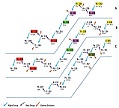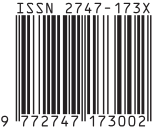Environmental Radioactivity Concentrations and Assessment of Radiological Hazards in Soil Around Bandung Nuclear Area
DOI:
https://doi.org/10.19184/cerimre.v5i2.31989Keywords:
Environment, Radiological, Hazard, Gamma, SpectrometryAbstract
Bandung nuclear area is an area which is nuclear reactor named TRIGA 2000 and research laboratory located. The reactor and research laboratory are utilized for training, researching and radioisotopes production that has potential to contaminate the environment. Environmental radioactivity monitoring is done periodically to find out potential radioactive release from activities inside Bandung nuclear area to surroundings. However, the assessment of radiological hazards to determine the potential radiological dangers to humans and environment around Bandung nuclear area is not done yet. The objective of this study is assessing the radiological hazards in Bandung nuclear area by comparing the data from soil samples taken in environment radiological monitoring activity with the recommendation data based on UNSCEAR and other references to find out the radiological hazards that potentially affect to humans, where this assessment has never been carried out in this area. The assessment of radiological hazards in this study is limited to Ra-226, Th-232 and K-40 nuclides because contributing to radiation dose received by human. The study was conducted by collecting soil samples from several sampling points inside and outside Bandung nuclear area. Then, the nuclides of Ra-226, Th-232 and K-40 contained in soil samples are measured by using the gamma-ray spectrometry method with high resolution detector that is HPGe (High Purity Germanium) and a computer-based Multichannel Analyzer (MCA). The results indicated that the concentration of environmental radioactivity ranged between 11.02 to 32.66 Bq/kg for Ra-226; 19.44 to 43.83 Bq/kg for Th-232 and 56.00 to 183.39 Bq/kg for K-40. This study also obtained results that the radiological hazard of the gamma dose rate ranged from 23.54 to 40.23 nGy/h, the radium equivalent was 51.77 to 89.78 Bq/kg; the external hazard index was 0.14 to 0.24 and the internal from 0.18 to 0.33; the index of radioactivity level was 0.37 to 0.63. The annual effective dose equivalent for outdoor ranged from 0.03 to 0.05 mSv/y and indoor was 0.12 to 0.20 mSv/y. The lifetime cancer risk for outdoors ranged from 0.10x10–3 to 0.17x10–3 and indoor was 0.4x10–3 to 0.69x10–3. The values of radiological hazard were below the international requirements. There is no potential risk of natural radiation of gamma ionizing radiation exposure in soil samples around the Bandung nuclear area for workers, the public, and the environment.
Keywords: Environment, Radiological, Hazard, Gamma, Spectrometry.








